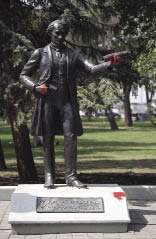Opinion: Why you should care about the John A. MacDonald statue debate
By Cameron Mitchell, Contributor

Patrick Johnson painted the hands of Regina’s John A. MacDonald statue red and will be in court later in September to face charges. Photo courtesy of Regina Leader-Post
Later in September, Patrick Johnson will be in court to face charges of mischief and a possible fine of $5,000 for painting red the hands of Regina’s John A. MacDonald statue. Johnson, a 47 year-old musician from Vibank, Sask., plans to plead guilty to the charges, which police were only able to lay after he came forward to claim responsibility for the incident.
According to the CBC, Johnson said he painted the statue of Canada’s first prime minister to “bring attention to the ongoing plight of First Nations people in Canada.”
August’s incident was not the first time this particular statue, the last of MacDonald to be found in a major western city, has been targeted. According to the Regina Leader-Post, Johnson claims he attempted to knock the hands off the statue with a sledge hammer on a previous occasion, only resorting to paint after he failed to make a dent. The CBC also reported that the statue was spray painted head to toe earlier in the year and vandalized in 2012.
The most recent incident comes amid a fierce debate over MacDonald’s legacy. Last year an Ontario teachers’ union urged school boards to consider removing MacDonald’s name from public schools in light of his role as leader of violence against Indigenous peoples. In Victoria, councillors voted this summer to remove his statue from the front steps of City Hall, replacing it with temporary plaque explaining that the decision was made in consultation with “the Lekwungen peoples, the Songhees and Esquimalt Nations, on whose territories the city stands.”
The reaction to these gestures towards reconciliation have been depressingly predictable. Onlookers wrapped themselves in British Columbian and Canadian flags, singing the national anthem as they gathered in Victoria to protest the removal of the statue. The problem these protestors have with the statue’s removal was best expressed by one man in an interview with the CBC: “It’s part of our history I feel is being ripped right out and gutted down.”
This and other variations of the ‘destroying history’ argument have often been on the lips of those opposing efforts to recontextualize MacDonald and other controversial historical figures. Never mind the fact that the express purpose in removing Victoria’s MacDonald statue was to present a more accurate accounting of history. Never mind the fact that, as writers for the Toronto Star point out, the statue in question was not erected until 1982, 100 years after MacDonald’s term as prime minister.
For those opposing the removal of the statues or the changing of school names, Victoria City Council’s gesture towards reconciliation amounts to little more than an Orwellian attempt to rewrite history. Not a week after the statue was removed, the National Post reported that the temporary plaque had been vandalized with the words “1984” and “communism” scrawled across it.
This reaction betrays a narrow-minded and frankly juvenile understanding of the past and the role history plays in the present. The lionizing of MacDonald in public discourse has played a key role in a ‘gutting’ of history that has already been taking place for over a century.
Despite what many Canadians might think, MacDonald was a controversial figure even in his day. Aside from being a notorious drunk, MacDonald was at the center of the Pacific Scandal, a campaign financing scandal that would force the resignation of his first government. His second government would see the implementation of the Chinese Head Tax and legislation denying Chinese Canadians the right to vote. The prime minister himself argued that Asian immigrants were incapable of naturalization, rhetoric that was viewed as extreme even among his contemporaries. As University of Ottawa historian Timothy J. Stanley points out in an article for the website ActiveHistory, “He was the only member of the Canadian Parliament to use the term ‘Aryan’ during the 1870s and 1880s, as well as the only member to argue that Asians and Europeans were separate species.”
This, of course, is in addition to his violent colonization of Canada’s Indigenous peoples.
The stories most present-day Canadians hear about MacDonald are only one side of the historical picture. Removing statues and renaming schools mark an attempt to make room for stories that, until recently, have been largely invisible. Not just so we can address historical wrongs, but also to address how MacDonald’s legacy continues to disenfranchise Indigenous people across the country to this day.
As University of Regina professor James Daschuk said to the CBC, “A lot of people defend Macdonald because he built the country and that’s no doubt true, but he built the dysfunctional country that we live in… One-hundred and forty years later, his policies, his actions [that he] oversaw them as the de facto minister of Indian Affairs, still have resonance in our society today.”
After all, one of MacDonald’s key legacies as prime minister was the creation of the residential school system which resulted in the deaths of at least 6,000 Indigenous children according to the Truth and Reconciliation Commission (the real number is likely higher). The last residential school only closed twenty-two years ago and many of the system’s victims and their children continue to suffer from their experiences.
As Canadians, it’s time to face the fact that we have a collective and often wilful amnesia when it comes to the violence upon which our country was founded. This amnesia is partly a product of our education system. When social studies curriculums across the country uphold MacDonald as ‘the father of confederation,’ they conveniently exclude MacDonald’s vision of Canada as an Aryan nation. When discussing the construction of the Canadian Pacific Railway, many educators have until recently been unaware of or unconcerned by the campaign deliberate starvation that project necessitated.
Both in his beliefs and in his actions, Canada’s first prime minister was what we would today call a white nationalist.
Which brings us back to the question of statues: can we continue to publicly venerate MacDonald in the 21st century?
The clear answer is that we can’t. It is irresponsible and immoral to continue the uncritical eulogizing of MacDonald in this supposed moment of reconciliation. Nobody is saying that MacDonald’s name should be stripped from the history books, merely that it should be placed in the context of all his actions, not just those that fit into our national mythology.
By removing MacDonald from the steps of City Hall, the Victoria City Council is taking a much-needed step in the right direction. The loss of one statue won’t cause Canadians to forget the ‘father of confederation.’ But it might give us the opportunity to revisit the fact that confederation itself would not have been possible without MacDonald’s brutal campaign of enforced starvation and colonial violence against Indigenous peoples.
Talking to the CBC, Regina Mayor Michael Fougere said the city has no plans to remove Victoria Park’s statue without a formal request from residents. Until a popular request is made, perhaps Patrick Johnson has the right idea. If John A. MacDonald is allowed to continue looming over our parks and public spaces, we should at least depict him with historical accuracy: with blood drenched hands.




